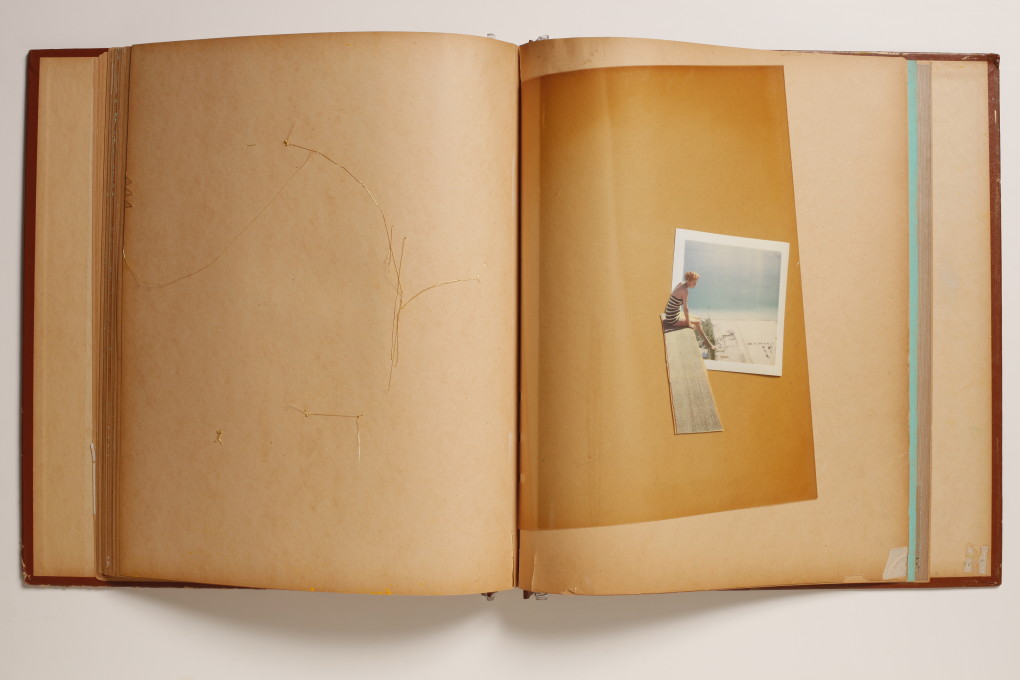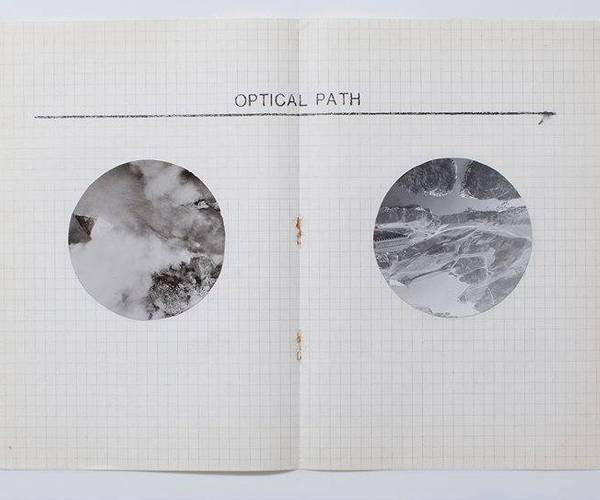During my visit to Berlin I went to the KW institute for contemporary art situated in Auguststraße.
Upon seeing Hajra Waheeds exhibition ‘still against the sky’ the first set of works – ‘The Scrap Book Project 2010-2011′ consisted of a series of between 20-30 images made using transferred images,photographs, drawings, print and collage. At first approaching the exhibition from a thin corridor I am guided throughout a wall of images. Hung in two rows neatly and carefully held in frames Waheed constructs images that from a distance appear to look like co-ordinates on a map or plans for a city to be built. They also had the duality of looking like they belonged as part of a film set depicting a family home- perhaps placed along the hallway- suggesting perhaps the viewer is the camera, smoothly glancing over each image. Some images warm, others more coded and darkly narrated. They demanded close attention, leaning closer I spent many moments with each image, looking back at others to keep track of my trail through the coded landscape I was making my way through.

There is a fragmentary nature to still against the sky – particularly the images which were made using the xylene transfer process. I imagined these found photographs had been discovered abandoned somewhere, lying on an empty coffee table/office desk with the light filtering through the window. The light gently warms the image and is ghosted onto the next blank page where the text used to be. There is a very solitary feel growing here, as a viewer you become the overseer connecting the events, it reminds me of the Wizard of Oz , in the scene looking though a crystal ball.

The use of negative space in the construction of the works is as vital and symbolic to the image as the central collaged compositions. This gave the work distance, but where the scale and perspective have been distorted. Where we see the outside of a building, the next image will show a portrait of a persons face. This alters the the experience in connecting the narrative of the works together. The large painted/drawn spaces became grids, a measuring device for the viewer. Embedded holes and margins on the edges of the browned paper suggested officialism, school books, and documents.
Situated in the space opposite were a series of cased works, a set of small square lined note books. Notebooks typically used as a recording tool to help process thoughts, a space to analyse and problem solve. ‘KH-21 Notes 2014′ features a set of circular grey scale images depicting planetary-esque surface drawings. I feel as though I am looking through a telescope, to another planet perhaps to observe the life that lives there. In the same way you would approach a telescope, you are made to peer down into the cases, as though observing specimens, analysing your subject to a high degree as you glimpse at the fuzzy details seen through a pyrex lens.

Presenting a form of analysis this way, the viewer has a sense of control and governance over the information you are permitted to see. You are prevented from reading through the notebooks as you would your own. The notebooks have transformed from the intimate to a more forced and formal. This builds into my relationship with the work, I am alienated from my human senses and natural instincts. I am now more machine like, functional, disconnected.
walking through the sliced narrow space,I am beginning to feel as though I am moving backward through time. The work guiding me, becoming like arrows pointing backwards.
In the next room which is smaller and more compact a series of works titled ‘Ariel Studies 1-8’. Presented in a linear format at eye level. You can scan, left to right very quickly in the same way a drone might as it makes an assessment of an area. They make me feel anxious, on the left are mostly aerial views of official buildings, such as ‘administration building – south-east’ and ‘engineering office building’ over to the right you can see more compact suburban areas, with labels ‘childrens playground’ used as divides for houses. Many houses, street names ‘ Mudarbaz avenue’ ‘to maple street’ look as though they are caught in a tide, the curving lines drifting, pushing them further out of the city. This perhaps suggests the shifting, slowly growing nature of power and gorvernance over a community of people.
Waheeds use of materials also have a strong connection to the narrative running through each body of work.
The use of Xylene transfers, carbon paper, unexposed polaroids symbolise how information is controlled, copied and delivered as second hand details. It also suggests the delay between when an event has happened, a missing link in communication, a loss of direct contact now a trail of clues.
In the past carbon paper was commonly used to duplicate cheques and in tracking slips for mail order. Other uses of carbon paper are to make fuel cells (a device that converts the chemical energy from a fuel into electricity through a chemical reaction of positively charged hydrogen ions with oxygen or another oxidizing agent.) Although processed differently I find a relevant connection to Waheeds work as ‘the first commercial use of fuel cells came more than a century later in NASA space programs to generate power for satellites and space capsules.’Link to quote source. Which links to works such as ‘Aerial studies 1-8’ and ‘KH-21 notes 2014’ whose themes poses questions about military reconnaissance satellite missions.
‘Still Against The Sky’ gave me the experience of secrecy, and disambiguity. I was given coordinates to a dream like sequence of events. Waheed’ work gave me hierarchies of information and memories in a world that appears to be still against the sky. Perspective and scale are dissected, rearranged, and fragmented so we are thrown into a state of flux.